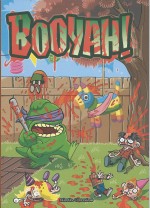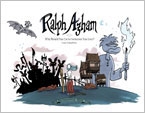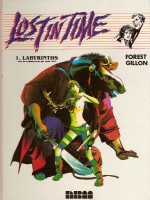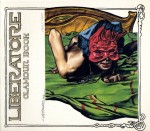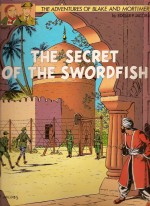
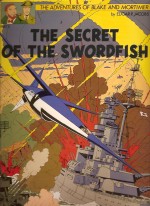
By Edgar P. Jacobs translated by Clarence E. Holland (Blake and Mortimer Editions)
ISBNs: 978-9-06737-005-9 & 978-9-06737-007-3
Belgian Edgard Félix Pierre Jacobs (March 30th 1904 – February 20th 1987) is rightly considered to be one of the founding fathers of the Continental comics industry. Although his output is relatively meagre compared to some of his contemporaries, the iconic series he worked on practically formed the backbone of the art-form in Europe, and his splendidly adroit yet roguish and thoroughly British adventurers Blake and Mortimer, created for the very first issue of Le Journal de Tintin in 1946, swiftly became an unmissable staple of post-war European kids’ life the way Dan Dare was in 1950s Britain.
Edgar P. Jacobs was born inBrussels, a precocious child who began feverishly drawing from an early age but was even more obsessed with music and the performing arts – especially opera. He attended a commercial school but loathed the idea of office work and instead avidly pursued the arts and drama on graduation in 1919.
A succession of odd jobs at opera-houses (including scene-painting, set decoration, and working as both an acting and singing extra) supplanted his private performance studies, and in 1929 Jacobs won an award from the Government for classical singing.
His proposed operatic career was thwarted by the Great Depression when the arts suffered massive cutbacks following the global stock market crash, and he was compelled to pick up whatever dramatic work was going, although this did include some singing and performing.
Jacobs switched to commercial illustration in 1940 with regular work in the magazine Bravo; as well as illustrating short stories and novels. He famously took over the syndicated Flash Gordon strip when the occupying German authorities banned Alex Raymond’s quintessentially All-American Hero and the publishers desperately needed someone to satisfactorily complete the saga.
Jacobs’ ‘Stormer Gordon’ lasted less than a month before being similarly embargoed by the Occupation forces, after which the man of many talents created his own epic science-fantasy feature in the legendary Le Rayon U, a milestone in both Belgian comics and science fiction adventure.
During this period Jacobs and Tintin creator Hergé got together, and whilst creating the weekly U Ray, the younger man began working on Tintin too, colouring the original black and white strips of The Shooting Star from the newspaper Le Soir for an upcoming album collection. By 1944 he was performing a similar role for Tintin in the Congo, Tintin in America, King Ottokar’s Sceptre and The Blue Lotus. By now Jacobs was also contributing to the drawing too, working on the extended epic The Seven Crystal Balls/Prisoners of the Sun.
After the war and liberation, publisher Raymond Leblanc convinced Hergé, Jacobs and a number of other comicstrip creatives to work for his proposed new venture. Founding publishing house Le Lombard, Leblanc also commissioned Le Journal de Tintin, an anthology comic with editions inBelgium,France andHolland edited by Herge, starring the intrepid boy reporter and a host of newer heroes.
Beside Hergé, Jacobs and writer Jacques van Melkebeke, the comic featured Paul Cuvelier’s ‘Corentin’ and Jacques Laudy’s ‘The Legend of the Four Aymon Brothers’. Laudy had been a friend of Jacobs’ since they worked together on Bravo, and the first instalment of the epic thriller serial ‘Le secret de l’Espadon’ starred a bluff, gruff British scientist and an English Military Intelligence officer (who was closely modelled on Laudy): Professor Philip Mortimer and Captain Francis Blake…
The initial storyline ran from issue #1 (26th September 1946 to September 8th 1949) and cemented Jacobs’ status as a star in his own right. In 1950, with the first 18 pages slightly redrawn, The Secret of the Swordfish became Le Lombard’s first album release with the concluding part published three years later. These volumes were reprinted nine more times between 1955 and 1982 with an additional single complete edition released in 1964.
In 1984 the story was reformatted and repackaged as three volumes with additional material – mostly covers from the weekly Tintin – added to the story as splash pages, and the first of these forms the basis for the English language book under discussion today.
Hergé and Jacobs purportedly suffered a split in 1947 when the former refused to grant the latter a by-line on new Tintin material, but since the two remained friends for life and Jacobs continued to produce Blake and Mortimer for the weekly comic, I think it’s fair to say that if such was the case it was a pretty minor spat. I rather suspect that The Secret of the Swordfish was simply taking up more and more of the diligent artist’s time and attention…
Although all the subsequent Blake and Mortimer sagas have been wonderfully retranslated and published by CineBook in recent years, this initial epic introductory adventure and its concluding two volumes remain frustratingly in the back-issue twilight zone, possibly due to their superficial embracing of the prevailing prejudices of the time.
By having the overarching enemies of mankind be a secret Asiatic “Yellow Peril†empire of evil, there’s some potential for offence – unless one actually reads the books and finds that any assumed racism is countered throughout by an equal amount of “good†ethnic people and “evil†white folk, so with no other version available I’m happily using these huge (312 x 232mm) 1986 iterations for this review.
And I’ll be reviewing those subsequent Cinebook tales by Jacobs and his successors in due course, but don’t wait for me… go out and get them all now!
Here and now, however, let’s recap Ruthless Pursuit, wherein a clandestine clique in the Himalayas launched a global Blitzkrieg at the command of Basam-Damdu, Emperor of Tibet. The warlord of a secret race of belligerent conquerors, whose arsenal of technological super-weapons were wielded by an army of the world’s wickedest rogues such as the diabolical Colonel Olrik dreamed of ruling the entire Earth and his sneak attack almost accomplished all his schemes in one fell swoop.
Happily however, English physicist Philip Mortimer and MI5 Captain Francis Blake were aware of the threat and were racing to finish the boffin’s radical new aircraft at a hidden British industrial complex. When the attack came the old friends swung into immediate action and narrowly escaped destruction in a devastating bomber raid…
The Golden Rocket launched just as Olrik’s bombers attacked and easily outdistanced the rapacious Empire forces, leaving ruined homes behind them as they flew into a hostile world now brutally controlled by Basam-Damdu…
Seeking to join British Middle East resistance forces, the fugitives’ flight ended prematurely and the Rocket crashed in the rocky wilds between Iran and of Afghanistan. Parachuting free, Blake and Mortimer survived a host of perils and escaped capture more than once as they slowly, inexorably made their way to the distant rendezvous, before meeting a British-trained native Sergeant Ahmed Nasir.
The loyal Indian had served with Blake during the last war and was delighted to see him again, but as the trio laboriously made their way to the target site, Olrik had already found it and captured their last hope…
Using commando tactics to infiltrate the enemy camp and stealing the villainous Colonel’s own Red-Wing super-jet, the heroes made their way towards a fall-back point but were again shot down – this time by friendly fire as rebels saw the stolen plane as an enemy target…
Surviving this crash too, the trio were ferried in relative safety by the apologetic tribesmen to the enemy-occupied town of Turbat and sheltered by a friendly Khan administrator. However the man’s servant, a spy of the Empire-appointed Wazir, recognised the Englishmen and Nasir realised too far late the danger they all faced…
Sending his loyal Sergeant away, Blake tried valiantly frantically to save Mortimer whilst a platoon of Empire soldiers rapidly mounted the stairs to their exposed room…
The frantic action begins in Mortimer’s Escape (alternatively titled The Fantastic Pursuit inside) with soldiers bursting into an empty chamber before being themselves attacked by the Khan. After a bloody firefight the Englishmen emerge from their cunning hiding place and flee Turbat, which has been seized by a furious spur-of-the-moment rebellion.
Unknown to the fugitives, the devious spy Bezendjas is hard on their heels and soon finds an opportunity to inform Olrik. With the city in flames and fighting in every street the callous colonel abandons his own troops to pursue Nasir, Blake and Mortimer into the wastes beyond the walls…
On stolen horses the heroes endure all the ferocious hardships of the desert but cannot outdistance Olrik’s staff-car. After days of relentless pursuit they reach the rocky coastline and almost stumble into another Empire patrol, and whilst ducking them Blake almost falls to his doom. Narrowly escaping death, the trio continue to climb steep escarpments and it is dusk before the Intelligence Officer realises that he has lost the precious plans and documents they have been carrying since they fled England…
Realising that somebody must reach the British resistance at their hidden Eastern base, the valiant comrades split up. Blake and Nasir continue onwards whilst Mortimer returns to the accident site. Finding the plans is a stroke of sheer good fortune, immediately countered by an ambush from Olrik’s troops.
Despite a Herculean last stand the scientist is at last taken prisoner but only after successfully hiding the lost plans…
Three weeks later Olrik is called to account in the exotic city-fortress ofLhasa. Basam-Damdu’s ruling council are unhappy with the Colonel’s lack of progress in breaking the captive scientist, and even more infuriated by a tidal-wave of sabotage and armed rebellion throughout their newly-conquered territories. Even Olrik’s own spies are warning him that his days as an agent of the Yellow Empire might be numbered…
Given two days to make Mortimer talk, the Colonel returns to his base inKarachijust as another rebel raid allows Nasir to infiltrate the Empire’s HQ. Blake is also abroad in the city, having joined British forces in the area.
With less than a day to act, the MI5 officer rendezvous with a British submarine and travels to a vast atomic powered secret installation under the Straits of Hormuz, where the Royal Navy are preparing for a massive counter-attack on the Empire. With raids liberating interned soldiers all the time, the ranks of scientists, technicians and soldiers are swelling daily…
Meanwhile, Nasir has begun a desperate plan to free Mortimer, who is still adamantly refusing to talk of the mysterious “Swordfish†Olrik’s agents continually hear rumours of…
Aware of his danger and the Sergeant’s efforts, Mortimer instead cunningly informs Nasir of the lost plans’ location, even as the impatient Emperor’s personal torturer arrives fromLhasa…
Always concerned with the greater good, Blake and a commando team secure the concealed plans and are met by Nasir who has been forced fromKarachiafter realising the spy Bezendjas has recognised him. It appears that time has run out for their scholarly comrade…
Mortimer, however, has taken fate into his own hands. When the sadistic Doctor Fo begins his interrogation, the Professor breaks free and escapes into fortress grounds during an earth-shattering storm. Trapped in a tower with only a handgun, he is determined to sell his life dearly, but is rescued by Blake and Nasir in a Navy Helicopter.
Using the storm for cover the heroes evade jet pursuit and an enemy naval sweep to link up with a British sub and escape into the night…
The saga concludes in SX1 Counter-Attacks: a tension-drenched race against time as
Blake, Mortimer and the last ofGreat Britain’s military forces prepare for a last ditch strike using the Professor’s greatest inventions to win freedom for the oppressed peoples of the world…
The story starts with a stunning reprise of past events (cunningly compiled from a succession of six full page illustrations which I assume were originally covers from the weekly Le Journal de Tintin), after which a daring commando raid frees a trainload of British prisoners. Brought to a fabulous subterranean secret base, the scientists and engineers discover an underground railway, factory and armaments facilities and even an atomic pile, all working furiously to complete the mysterious super-weapon dubbed “Swordfishâ€.
The liberated men all readily join the volunteers, blithely unaware that Olric is amongst them in a cunning disguise. Even as preparations for the Big Push rapidly produce results, a series of disastrous accidents soon lead to one inescapable conclusion: there is a saboteur in the citadel…
Eventually Olrik becomes overconfident and Mortimer exposes the infiltrator in a crafty trap, but after a fraught confrontation the Colonel escapes after almost causing a nuclear catastrophe. Fleeing across the seabed, the harried spy narrowly avoids capture by diver teams and even a hungry giant octopus…
The flight takes its toll upon Olrik and he barely reaches land alive. Luckily for him Bezendjas had been checking out that area of coastline and finds the rogue trapped in his stolen deep-sea diver suit. After a lengthy period the dazed desperado recovers and delivers his hard-won information. Soon all the region’s Imperial forces are converging on the British bastion…
As air and sea forces bombard the rocky island and sea floor citadel, Olrik dispatches crack troops to break in via a revealed land entrance resulting in a staggering battle in the depths of the Earth.
They were almost in time…
After months of desperate struggle, however, Mortimer and his liberated scientists have completed Swordfish: a hypersonic attack plane with uncanny manoeuvrability and appallingly destructive armaments.
Launched from beneath the sea, the sleek and sinister plane single-handedly wipes the Empire jets from the skies before sinking dozens of the attacking naval vessels. Ruthlessly piloting SX1 is Francis Blake; and even as he wreaks havoc upon the invading force he is joined by SX2 – a second unstoppable super-jet…
Soon the Yellow Empire is in full retreat and a squadron of Swordfish is completed. With the occupied planet in full revolt, it’s not long before Lhasa itself gets a taste of the flaming death it callously inflicted upon a peaceful, unsuspecting and now most vengeful world…
They were only just in time: the insane and malignant Emperor was mere moments away from launching a doomsday flight of missiles to every corner of the planet he so briefly owned…
Gripping and fantastic in the best tradition of pulp sci-fi and Boy’s Own Adventures, the exploits of Blake and Mortimer are the very epitome of True Brit grit and determination, always delivering grand old-fashioned Blood and Thunder thrills and spills in timeless fashion and with staggering visual verve and dash. Despite the high body count and dated milieu, any kid able to suspend modern mores and cultural disbelief (call it an alternative earth history if you want) will experience the adventure of their lives… and so will their children.
© 1986, 1987 Editions Blake & Mortimer. All rights reserved.
